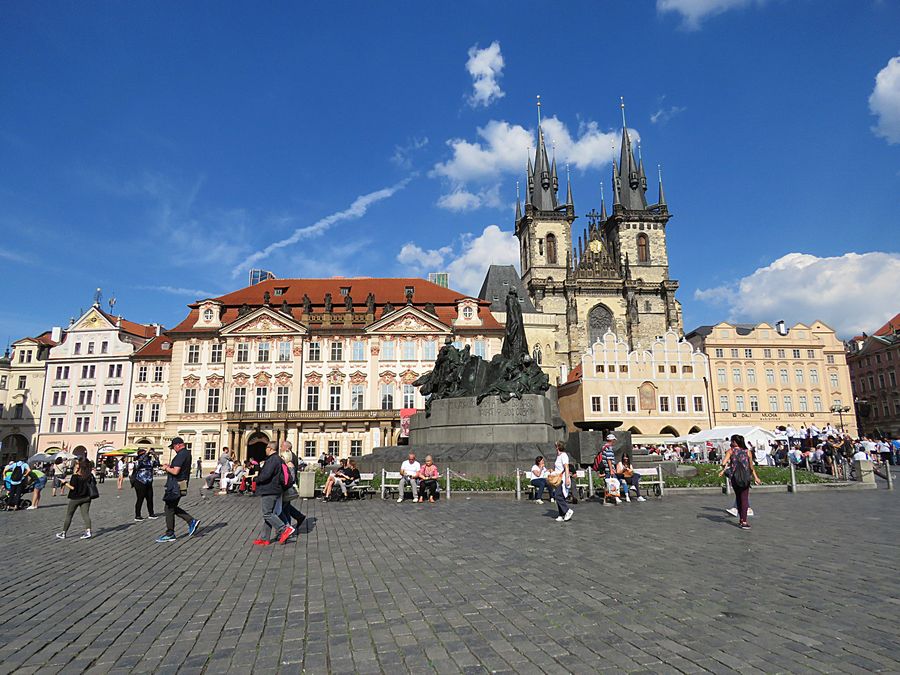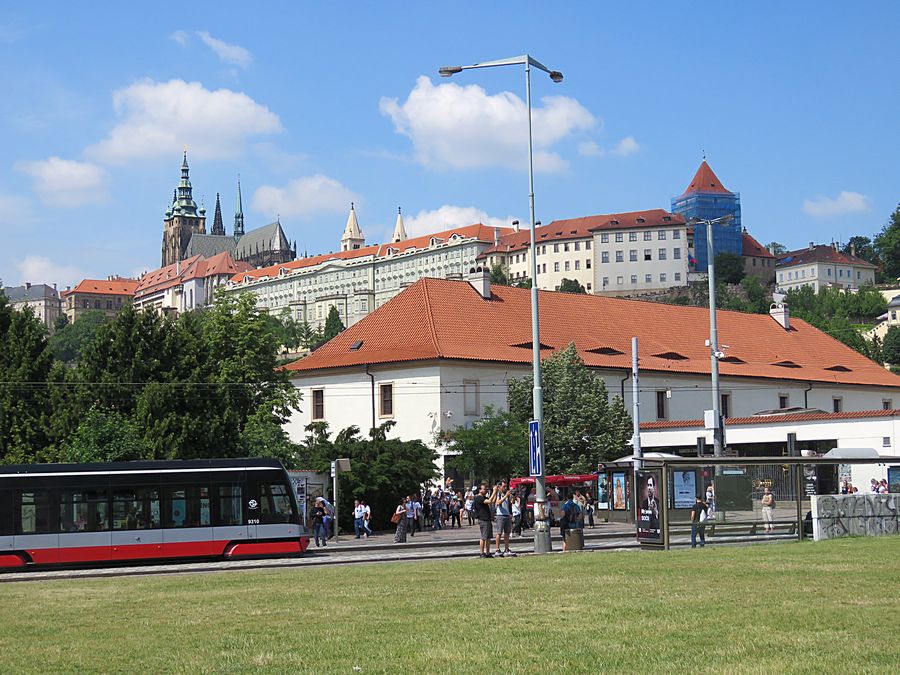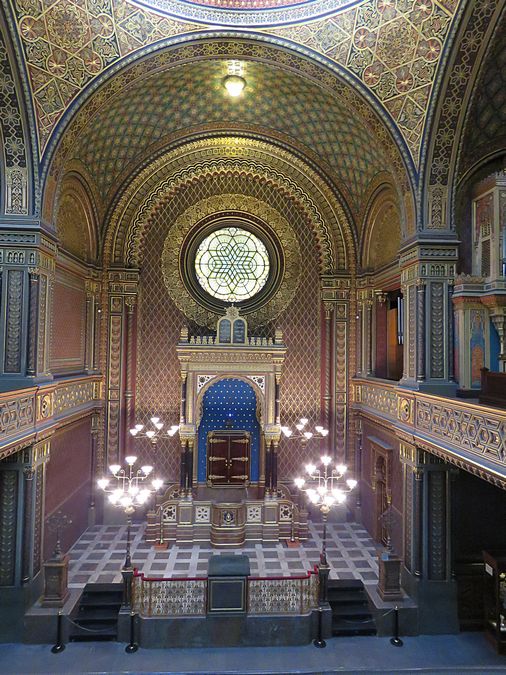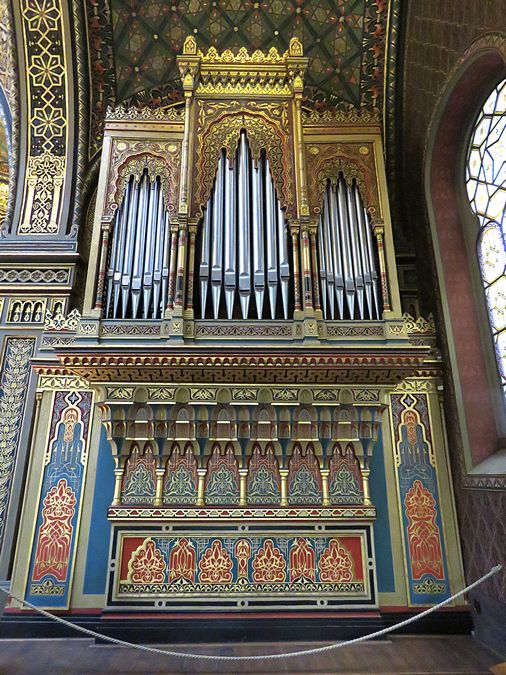Jewels of Bohemia - May 23 - June 6, 2018
(Czech Republic, Slovakia, Hungary)
Part One, Czech Republic
Page One, Prague
The area known as the Czech Republic has been settled since the
Neolithic era. The Czech Republic includes the historical territories
of Bohemia, Moravia, and Czech Silesia. The Czech state was formed
in the late 9th century as the Duchy of Bohemia under the Great Moravian Empire.
After the fall of the Empire in 907, the center of power transferred from Moravia to Bohemia.
In 1002, the duchy was formally recognized as part of the Holy Roman Empire
and became the Kingdom of Bohemia in 1198, and the King of Bohemia
had a vote in the election of the Holy Roman Emperor. In the Hussite Wars of the 15th century
driven by the Protestant Bohemia Reformation, the kingdom faced economic embargoes and
defeated five consecutive crusades proclaimed by the leaders of the Catholic Church.
The whole Crown of Bohemia was gradually integrated into the Hapsburg Monarchy
alongside the Archduchy of Austria and the Kingdom of Hungary. The Protestant Bohemian
Revolt (1618–20)
against the Catholic Hapsburgs led to the Thirty Years' War.
Eventually the Hapsburgs consolidated their rule, eradicated Protestantism and reimposed Catholicism
and a policy of gradual Germanization. This contributed to anti-Hapsburg sentiment.
A long history of resentment of the Catholic Church followed and still continues. With the
dissolution of the Holy Roman Empire in 1806, the Bohemian Kingdom became part of the Austrian Empire.
After being the seat of Bohemia, a key stronghold of the Holy Roman Republic, and
later the Austro-Hungarian Empire, Czechoslovakia emerged as an autonomous
country after the collapse of the latter empire following World War I. The Czech part
of Czechoslovakia was occupied by Germany in World War II,
while the Slovak region became the Slovak Republic. Czechoslovakia was
liberated in 1945 by the armies of the U.S. and the Soviet Union. The Czech
country lost the majority of its German speaking inhabitants after they
were expelled following the war. The Communist Party of Czechoslovakia won the
1946 elections and after the 1948 coup d'etat, Czechoslovakia became a one party
communist state under Soviet influence. In 1968, increasing dissatisfaction with the regime
culminated in a reform movement known as the Prague Spring, which ended in a Soviet
led invasion. Czechoslovakia remained occupied until the 1989 Velvet Revolution,
when the communist regime collapsed and a market economy was reintroduced.
On January 1, 1993, Czechoslovakia peacefully dissolved, with its constituent states
becoming the independent states of the Czech Republic and Slovakia.
The Czech Republic joined NATO in 1999 and the EU in 2004.
After centuries of being ruled by monarchs, the country has now
become a parliamentary democracy with Prague as its capital. It has a
"continental" European social model, including a universal health care system and
tuition-free university eduation. It is one of the most non-religious countries in the world.
(Roman Catholic 10.4%, Protestant 1.1%, other or unspecified 54%, none 34.5%)
It has a population over 10.6 million people.
Page One - Prague

Old Town (Stare Mesto) Square in Prague
Prague is the capital and largest city, the 14th largest city in the European Union,
and the historical capital of Bohemia. Situated in the northwest of the country on
the Vltava river, the city is home to about 1.3 million people, while its larger urban
zone is estimated to have a population of 2.6 million. In the middle of Old Town Square
is the memorial to Jan Hus, the Czech philosopher whose criticism of the Catholic
Church sparked religious conflicts long before Martin Luther's time. The Gothic towers
on the right are part of Tyn Church, built around 1360. It has been a Catholic, then
Protestant, then Catholic Church again.

St. Vitus Cathedral at Prague Castle
This cathedral is an example of Gothic architecture and is the largest and most
important church in the country. Located within Prague Castle, it contains tombs
of many Bohemian kings and Holy Roman Emperors. The cathedral is owned by
the Czech government as part of the Prague Castle complex.

Inside St. Vitus Cathedral

Part of the Golden Gate of St. Vitus Cathedral. Dating back to the 1370s and built
by Charles IV's favorite architect, the three-arched portal was the final stop on
the Royal Coronation Route of the Kings of Bohemia. The mosaic is a triptych
that depicts the second coming of Jesus Christ. The central image on the mosaic
is Christ, surrounded by angels. The angels surrounding him are carrying trumpets
to signify the coming of the Lord. Underneath him, six Czech patron saints are kneeling.

View of Prague and Vltava River from Prague Castle area. In the foreground is
Mala Strana, the Little Quarter district that is linked to Old Town, Stare Mesto,
by the Charles Bridge.

Charles Bridge, a historic bridge that crosses the Vltava River in Prague. Its construction
started in 1357 under the auspices of King Charles IV, and finished in the beginning of the
15th century. As the only means of crossing the river until 1841, Charles Bridge was the
most important connection between Prague Castle and the city's Old Town and adjacent areas.

Prague Castle (above), a castle complex dating from the 9th century. It is now the official
office of the President of the Czech Republic. The castle was a seat of power for kings of
Bohemia, Holy Roman emperors, and presidents of Czechoslovakia. The Bohemian Crown
Jewels are kept within a hidden room inside it.

Street scene in Prague

Old-New Synagogue, Europe's oldest active synagogue.
It is in Josefov, Prague's Jewish Quarter, located between the Old Town Square
and the Vltava River. It is part of the Jewish Museum in Prague, which consists
of 4 synagogues, a ceremonial hall, and a cemetery.

Typical old architecture in Prague

Part of the Jewish Museum - Maisel Synagogue. It now houses an exhibit on Jewish
history in the Czech lands. During the Nazi occupation, this building became a
warehouse for a collection of things pertaining to Jewish life and customs that
Hitler planned to turn into a "Museum of the Extinct Jewish Race." Perhaps this
explains why these items and the Jewish Quarter managed to survive that period.

Statue of Franz Kafka by Jaroslav Róna, installed on Vezenska street in the
Jewish Ghetto area. Kafka is riding on the shoulders of a huge man.

Inside the Spanish Synagogue, the most recent synagogue in the Prague Jewish
Ghetto. Built in 1868 for the local Reform congregation on the site of the 12th
century Altschul, which was the oldest synagogue in the Prague ghetto.
It was called the Spanish Synagogue for its impressive Moorish interior design,
influenced by the famous Alhambra.

Organ in the Spanish Synagogue

Inside the Pinkas Synagogue, used now as a memorial to the Holocaust victims. It
has the names of the 77,297 Czech Jews who were murdered during the Holocaust
inscribed on the walls. On the second level, there is a heartbreaking collection of art
created by child inmates at the Terezin concentration camp outside Prague. Here is
one of the drawings.

Old Jewish Cemetery, where Prague's Jews buried their dead. Since space in the
ghetto was limited, and it was against Jewish law to disturb graves, residents had
no choice but to bury bodies on top of bodies, raising the ground level several feet.

Street scene in Prague Old Town area

Street artist

Another street scene

Outdoor Sausage shop on a street near our hotel.
3 of us bought a light dinner here
one evening. We had many opportunities to eat sausage.
Link to Page Two - Prague continued
Pat's Home Page